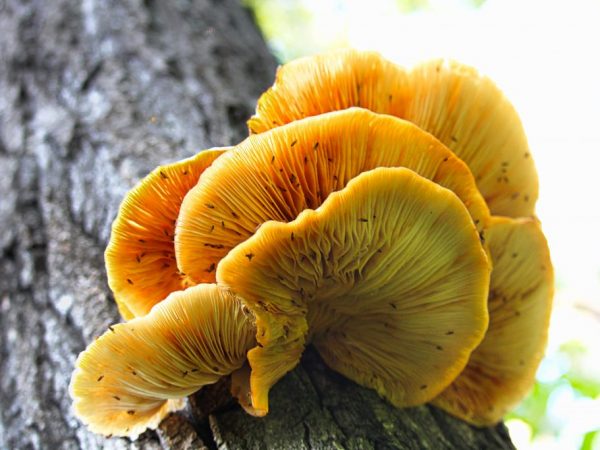The main differences between false oyster mushrooms
When asked whether false oyster mushrooms are poisonous, you can definitely answer - yes. But they only grow in Australia. In our latitudes, inedible or conditionally edible varieties are found. It is not difficult to distinguish such mushrooms.

The main differences between false oyster mushrooms
Orange oyster mushroom
Orange oyster mushroom, according to the species description, grows in large families mainly in deciduous forests. Found on linden, aspen, birch, prefers rotten stumps, dead wood. Feels good in temperate climates. Fruiting begins in September and lasts until November. In warm areas, the mushroom can grow even in winter. Rare. It stands out strongly against the green background of foliage, thanks to the bright orange color of the cap. If oyster mushrooms survive the winter, the color becomes paler.
The main differences include:
- almost complete absence of a leg: mushrooms are attached to the wood with a cap;
- the cap is 2-8 cm in diameter, fan-shaped;
- the skin is fluffy and tough;
- unusual smell: young specimens have a melon aroma, mature ones smell like rotten cabbage;
- hymenophore: lamellar, its color is brighter (darker) than the color of the cap;
- the pulp is bitter, pale orange;
- spores are elongated, smooth;
- spore powder light pink or brownish pink.
Irina Selyutina (Biologist):
Sometimes you can meet orange oyster mushroom on sick or dying trees. Old reference books wrote rather evasively that this mushroom was “conditionally edible”. Many modern identifiers indicate that this is a mushroom from the category of "inedible" (but not poisonous). Some mushroom pickers collect them, but only young fruit bodies with a melon aroma, but the old ones are bypassed because of the quality and a very unpleasant smell - some describe it as rotten cabbage, others as rotting carrots.
The mycelium of orange oyster mushroom, if desired, can be found in the product catalog of some online seed stores, because it is advertised as a garden decoration, albeit inedible.
Orange oyster mushroom is used for landscape design. It is used to decorate gardens and yards, infecting trunks and tree stumps with mycelium.
Wolf saw-leaf
Wolfshawthorn also does not belong to the poisonous counterparts of edible oyster mushrooms. Its second name is bald sawnose. It grows on dead tree trunks and stumps. It is rarely found in deciduous and coniferous forests. It grows in Central Russia, North America, Canada, Europe (except for the southern regions). Fruiting from July to October.
To distinguish a mushroom, you should carefully study its description:
- the cap is kidney-shaped or lingual, 3-8 cm in diameter, the skin color is whitish-brown, yellow-red;
- the leg is dense, colored brown, almost black, not centered, 1 cm long, rudimentary (lost its significance in the process of evolution);
- the surface of the cap is felt, with small scales and growths;
- hymenophore: represented by plates, at first they are white-yellow, then they turn red, descending along the leg, frequent, wide;
- uneven, jagged edge on the back of the cap (the main difference), bent down;
- the flesh is whitish, tough, pungent;
- aroma is pronounced, mushroom;
- spore white powder.
The caps sometimes grow together to form groups. Wolfshawthorn is not used in cooking because of its pungent taste, which does not disappear even after prolonged heat treatment.
Oyster mushroom green

Mushrooms need to be cooked properly
Oyster mushroom is often referred to as a false species. If not boiled properly, it will not be edible. The mushroom is of low quality, conditionally edible. Its second name is late oyster mushroom (autumn). The species is distinguished by late fruiting: from September to the first frost. Autumn oyster mushrooms resume their growth during thaws. They are found in February and March.
These mushrooms are found in mixed and deciduous forests of the European part of Russia, Ukraine, the Caucasus, and North Asia. They are found individually or by families. They grow on wood, stumps and dead wood.
This type of mushroom is easy to distinguish, knowing its description:
- the cap is lateral, tongue-shaped, with a diameter of 3-15 cm;
- color from olive-brown to yellow-brown, turns pale in mature specimens;
- the skin is velvety, slimy in damp weather;
- the leg is short (up to 3 cm), dense, ocher-yellow, may be absent;
- the plates of the hymenophore are frequent, whitish in young mushrooms, then yellow-brown or olive;
- spore powder white-violet.
Overripe mushrooms become hard. After suffering frosts, they completely lose their taste. If the cold snap is prolonged, the fruiting bodies become unusable. They turn sour and die, as evidenced by the wine smell and mold on the plates.
Conclusion
There are not many false species of oyster mushrooms growing on our territory. They are not poisonous, but you should not eat such mushrooms: their pulp contains many substances that give it bitterness.
Even species that are suitable for use in cooking can cause poisoning. Fruit bodies collected in the wrong place (near the road, industrial enterprises) are oversaturated with harmful substances absorbed from the environment. Even improper storage and preparation will degrade the quality of the food.



